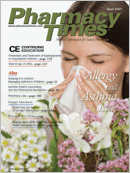Publication
Article
Pharmacy Times
generic times: product profiles
Author(s):
Metoprolol Extended-releaseTablets
The hazards of misinterpretingsound-alike and look-alike drugs arebecoming an increasing concernamong clinicians. In 2005, the FDA distributeda letter warning about medicationerrors involving the beta-blockermetoprolol, whose brand name Toprolwas being confused with Topamax andTegretol on some hospital orders andoutpatient prescriptions. The lettersuggested using both brand and genericnames when ordering this trio ofmedications.
Metoprolol, indicated for the treatmentof hypertension, angina, andheart failure, has recently becomeavailable as a generic in its extended-releaseversion. Current genericsources for metoprolol extended-releasetablets are limited to the 25-mgstrength, available from Par PharmaceuticalCompanies Inc and Sandoz.
Pharmacology
Unlike some beta-blocking drugs,metoprolol demonstrates selectiveinhibition of beta1 adrenergic receptorsat low doses. Only at higher doses doesbeta2 inhibition occur.
The exact mechanism of effect ofbeta-blockers has not been fully determined.Some studies suggest a decreasein sympathetic outflow from thecentral nervous system; others note asuppression of renin release. At thecardiac level, the reduction of heartrate and blocking of catecholaminebasedactivity is thought to explain itseffectiveness for angina.
Dosage and Administration
Metoprolol is available in extended-releaseformulations to enhance convenienceand patient adherence. Forhypertension, the extended-releasedose begins with a daily dose of 25 to100 mg, with a 400-mg daily maximum.For angina, polymorphic ventriculartachycardia, and prophylaxis of heartattack, the initial daily dose is 100 mg,with the same 400-mg daily limit.Elderly patients should initiate treatmentwith 25 to 50 mg daily as a singledose, with increases at 1-to 2-weekintervals.
Unlike many extended-release formulations,scored metoprolol can bedivided into half tablets with a constantdrug delivery over 24 hours. Nevertheless,the whole or half tabletsshould not be further chewed orcrushed.
Safety Profile
Metoprolol should be avoided in thepresence of sick sinus syndrome orsinus-mediated bradycardia, in severeperipheral artery disease, and duringthe final 2 trimesters of pregnancy.Beta blockade presents a challengewith concurrent bronchial diseasestates, such as asthma. Metoprolol hasgreater beta1 specificity, however, andwith careful monitoring can be employedwith coexisting bronchospasticdisorders.
Patients with diabetes may experienceadditive hypoglycemic effectswith beta-blockers; metoprolol appearsto be well-tolerated among thispatient population. The use of calciumchannel blockers such as verapamilor diltiazem, however, may still potentiatebradycardia or induce heartblock.
Other drug interactions includeenhanced vertigo with alpha-blockingdrugs such as prazosin or terazosin;bradycardia and hypotension may beamplified with concurrent use of selectiveserotonin reuptake inhibitors andphenothiazines, or drugs that inhibitthe CYP2D6 metabolic enzyme.
Several naturopathic treatmentsmay also affect metoprolol activity bytheir action on the body's vasopressorresponse. Gotu kola, licorice, andephedra may interfere with the hypotensiveeffects of metoprolol, whilehawthorn and quinine may enhancethe blood pressure-lowering effects inunpredictable ways.
When beta-blocker therapy is to bewithdrawn, it should be done slowly toavoid rebound tachycardia, hypertension,or cardiac ischemia.
Clinical Outlook
Metoprolol extended-release tabletsoffer a more effective means of maintaininguniform plasma levels and therapeuticresponse than their immediate-release relatives. At a single dailydose, they offer a convenient opportunityto promote adherence, especiallyamong patients receiving therapy involvingmultiple drugs.
Pilocarpine Oral Tablets
Sjögren's syndrome is a disease thatcrosses all populations, locations, andage groups. Women are more prone tothe condition, with the average age forpeak symptoms occurring betweenages 40 and 60 years. The salivaryglands are infiltrated by lymphocytes,decreasing parotid flow of saliva. Themain symptom of xerostomia may becombined with dry eyes and can alsobe a consequence of connective tissuediseases such as rheumatoid arthritisor lupus.
Treatment of Sjögren's syndrome isdirected at the xerostomia, with cholinergicstimulation being considered amost effective therapy. Pilocarpine is aclassic cholinergic agent useful for thiscondition, now available generically in2 strengths. The 5-mg tablets are availablefrom Sandoz, Actavis, RoxaneLaboratories, and Lannett Co Inc. The7.5-mg tablets are manufactured byActavis.
Pharmacology
A classic stimulator of the salivationlacrimation-urination-defecation response,pilocarpine is a cholinergic drug that actsupon muscarinic receptors.
Dosing and Administration
In addition to Sjögren's syndrome,pilocarpine tablets are useful in treatingxerostomia resulting from cancerradiation therapy to the neck and head.
Dosing for Sjögren's syndrome isgenerally 5 mg, taken up to 4 timesdaily. For xerostomia secondary to cancertherapy, the dose generally beginsat 5 mg 3 times daily, with titration upto 10 mg 3 times daily. Most patientsrequire a total daily dose of 20 mg.Single doses above 10 mg and totaldaily doses above 30 mg are not recommended.The dosing should be continuedfor a minimum of 90 days toobtain maximum effectiveness.
Whereas taking pilocarpine tabletsafter eating helps reduce some of itsuntoward gastrointestinal effects, highfatmeals will diminish its effective rateof absorption.
Safety Profile
Pilocarpine tablets are contraindicatedfor patients with poorly controlledasthma, glaucoma, or severe hepaticimpairment. Caution is also necessarywith the presence of gallstones, nephrolithiasis,or biliary tract disease. Thecholinergic nature of pilocarpine bringsgastrointestinal effects of diarrhea,nausea, vomiting,and excessive salivation.Sweating is also likely.
The use of oral pilocarpine is not recommended forpatients under the age of 6 years.Atropine is the favored antidote inthe case of overdose, with epinephrine employedto treat possible respiratory or cardiovascularconsequences of oral pilocarpine use.
Although oral pilocarpine maybe effective in reducingxerostomia caused by antidepressantsand other drugs, theFDA has not grantedapproval forthat indication dueto lack of specificclinical studies.
Clinical Outlook
Sjögren's syndrome, initially countedamong the registry of rare disorders, isnow considered the second most commonautoimmune rheumatic disease,with an incidence in nearly 3 millionpeople in the United States alone. Italso represents a major health problemamong women that is regarded asunderdiagnosed or treated. Fortunately,symptomatic treatment is availablewith the generic versions of pilocarpinetablets.
Mr. Middleton is an instructor of pharmacologyat Kellogg CommunityCollege in Battle Creek, Mich.







